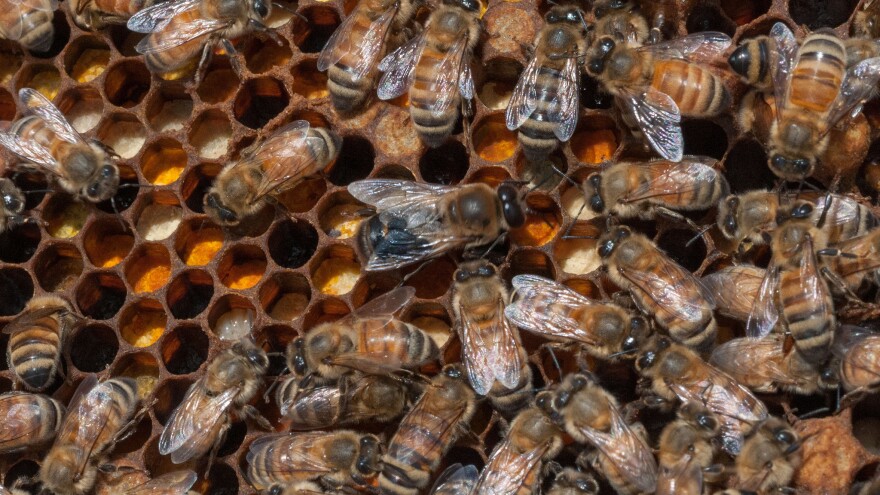Backyard beekeeping is a dying art in the American Southwest, in large part because of the invasion of Africanized bees. They’re more defensive than European honey bees, and that takes the charm out of the hobby. But they also have more resilient genes. So despite their nasty reputation, some beekeepers want to work with Africanized bees. That’s easier to do in northern Arizona, where cooler temperatures mean calmer bees.

Beekeeping starts with taking precautions: put on a veil, wear gloves, calm the bees down with a few puffs of smoke.
Patrick Pynes heads up the Northern Arizona Organic Beekeepers Association. He’s checking on the progress of one of his Flagstaff colonies. The hive is simple: a trough with wooden bars across the top. Pynes lifts a bar out and inspects the oozing honeycomb. The bees don’t seem to mind.

“See this girl looking at me?” Pynes says. “She’s just making sure that I’m not a threat. She’s a guard bee. I’ll move real slowly, make sure she feels OK.”
This hive is Africanized. In the 1990s there was a conspicuous migration of Africanized bees from Central and South America to the United States. They thrive in hot climates. They interbreed with domestic bees and infiltrate their hives. And they’re more prone to attack people or animals.

But none of that worries Pynes. “I don’t really like docile bees, they don’t have much to teach us,” he says. “You really learn a lot when they sting you.”
Pynes believes the Africanized bee is useful. It’s genetically more resilient to disease and parasites – and that matters, in a world where European honey bees are dying in droves.

Those stronger genetics come packaged with a nasty attitude, so most beekeepers don’t want to work with feral bees. But it’s a bit easier in northern Arizona. Scientists and beekeepers speculate it might be too cold here for Africanized bees to really take over. Instead, they mix with European colonies. No one really knows what the result will be, but wild bees in the Flagstaff area seem to be more relaxed, with just a touch of toughness.
Suze Manci captures wild swarms for her backyard hives. “We vacuum them up or scoop them up with our hands depending on where the swarm is,” she says. “I think it’s fun; probably some people think it’s crazy.”

Manci’s on a small crusade to save the wild bees. She’s asked a local pest control company to call her when someone reports a swarm, so she can take it home or relocate it to a safe place. Her bees might be partly Africanized, but they’ve always been good houseguests.
“If they were aggressive, I would not have brought them home,” Manci says, “because that wouldn’t be fair to me, or them, or the neighbors, or the neighbor’s dog.”


No one tracks the number of backyard beekeepers, but Arizona’s commercial honey production has gone down since the arrival of the Africanized bee. Even so, there’s enough interest in northern Arizona to attract a new generation of bee enthusiasts. Payton Taylor started keeping bees in his Sedona backyard two years ago. He was thirteen.
“I think it is an unusual hobby to have,” Taylor says. “I can’t say I know anyone else in my age group who keeps bees.”
Taylor’s hives are imported European bees. He says their personalities change as they interact with wild Africanized bees. He checks up on them a couple of times a month, to make sure they’re healthy and are stocking up enough honey for the winter.

I ask him what the most rewarding part of keeping bees is. “I guess part of it is honey,” he replies. “The honey is great—that’s what most people would tell you right off the bat. But I don’t know” – and here he gets thoughtful for a moment—“I think the best thing about it is it really teaches you to be patient and to be diligent. I think it teaches me, and I assume other people, how to be more patient while they’re working and make sure they don’t make mistakes.”
Backyard beekeepers will need that kind of patience in places like northern Arizona, where the wild and the domestic aren’t easy to keep apart.









